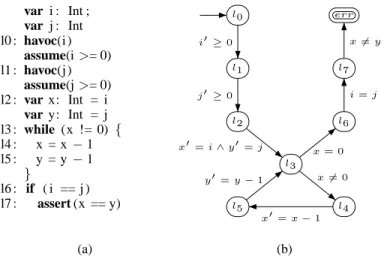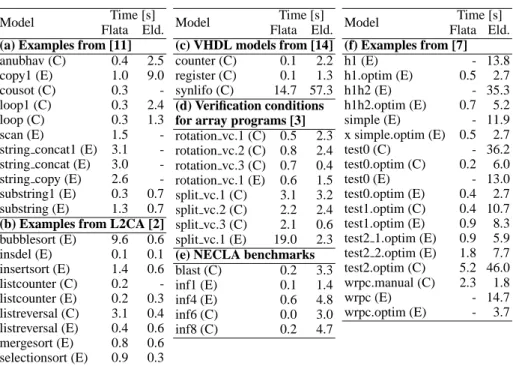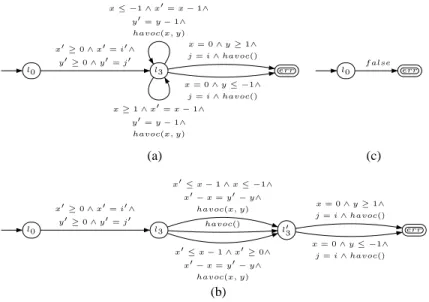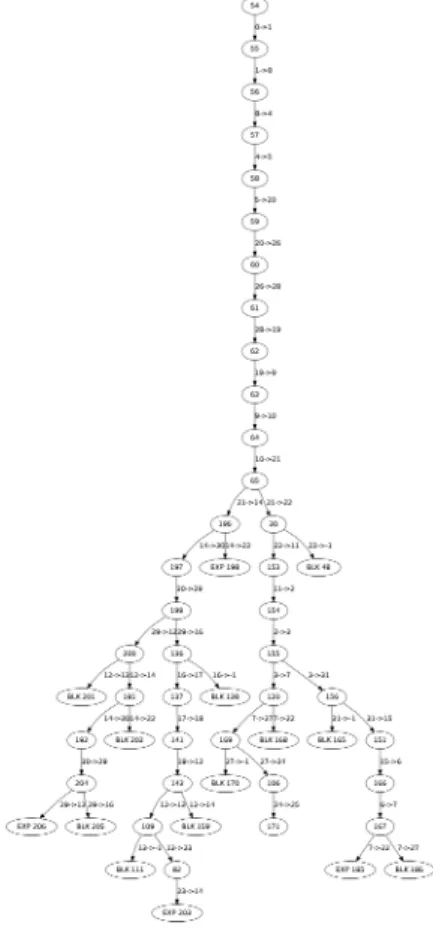HAL Id: hal-01418901
https://hal.archives-ouvertes.fr/hal-01418901
Submitted on 17 Dec 2016
HAL is a multi-disciplinary open access
archive for the deposit and dissemination of
sci-entific research documents, whether they are
pub-lished or not. The documents may come from
teaching and research institutions in France or
abroad, or from public or private research centers.
L’archive ouverte pluridisciplinaire HAL, est
destinée au dépôt et à la diffusion de documents
scientifiques de niveau recherche, publiés ou non,
émanant des établissements d’enseignement et de
recherche français ou étrangers, des laboratoires
publics ou privés.
Public Domain
A Verification Toolkit for Numerical Transition Systems
Tool Paper ⋆
Hossein Hojjat, Florent Garnier, Radu Iosif, Filip Konečny, Viktor Kuncak,
Philipp Rümmer
To cite this version:
Hossein Hojjat, Florent Garnier, Radu Iosif, Filip Konečny, Viktor Kuncak, et al.. A Verification
Toolkit for Numerical Transition Systems Tool Paper ⋆. 18th International Symposium on Formal
Methods, Aug 2012, Paris, France. �hal-01418901�
Tool Paper
⋆Hossein Hojjat1, Florent Garnier2, Radu Iosif2, Filip Koneˇcn ´y2, Viktor Kuncak1, and Philipp R¨ummer3
1
Swiss Federal Institute of Technology Lausanne (EPFL)
2
Verimag, Grenoble, France
3
Uppsala University, Sweden
Abstract. This paper reports on an effort to create benchmarks and a toolkit for rigorous verification problems, simplifying tool integration and eliminating am-biguities of complex programming language constructs. We focus on Integer
Nu-merical Transition Systems (INTS), which can be viewed as control-flow graphs
whose edges are annotated by Presburger arithmetic formulas. We describe the syntax, semantics, a front-end, and a first release of benchmarks for such tran-sition systems. Furthermore, we present FLATAand ELDARICA, two new verifi-cation tools for INTS. The FLATAsystem is based on precise acceleration of the transition relation, while the ELDARICAsystem is based on predicate abstrac-tion with interpolaabstrac-tion-based counterexample-driven refinement. The ELDARICA
verifier uses the PRINCESStheorem prover as a sound and complete interpolat-ing prover for Presburger arithmetic. Both systems can solve several examples for which previous approaches failed and present a useful baseline for verifying integer programs. Our infrastructure is publicly available; we hope that it will spur further research, benchmarking, competitions, and synergistic communica-tion between verificacommunica-tion tools.
1
Introduction
Common representation formats, benchmarks, and tool competitions have helped re-search in a number of areas, including constraint solving, theorem proving, and com-pilers. To bring such benefits to the area of software verification, we are proposing a standardized logical format for programs, in terms of hierarchical infinite-state tran-sition systems. The advantage of using a formally defined common format is avoiding ambiguities of programming language semantics and helping to separate semantic mod-eling from designing verification algorithms.
This paper focuses on systems whose transition relation is expressed in Presburger arithmetic. Integer Numerical Transition Systems, (denoted INTS throughout this pa-per), also known as counter automata, counter systems, or counter machines, are an infinite-state extension of the model of finite-state boolean transition systems, a model extensively used in the area of software verification [10]. The interest for INTS comes from the fact that they can encode various classes of systems with unbounded (or very large) data domains, such as hardware circuits, cache memories, or software systems with variables of non-primitive types, such as integer arrays, pointers and/or recursive data structures.
Any Turing-complete class of systems can, in principle be simulated by an INTS [12]. Despite this expressiveness, a number of recent works have revealed cost-effective ap-proximate reductions of verification problems for several classes of complex systems to decision problems, phrased in terms on INTS. Examples of systems that can be effec-tively verified by means of integer programs include: specifications of hardware compo-nents [14], programs with singly-linked lists [2], trees [8], and integer arrays [3]. Hence the growing interest for analysis tools working on INTS.
2 Hojjat, Garnier, Iosif, Koneˇcn´y, Kuncak, R¨ummer var i : Int ; var j : Int l0 : havoc(i ) assume(i >= 0) l1 : havoc(j ) assume(j >= 0) l2 : var x: Int = i var y: Int = j l3 : while (x != 0) { l4 : x = x− 1 l5 : y = y− 1 } l6 : if ( i == j ) l7 : assert (x == y) l0 l1 l2 l3 l4 l5 l6 l7 err i′≥0 j′≥0 x′= i ∧ y′ = j x6= 0 x′= x − 1 y′= y − 1 x= 0 i= j x6= y (a) (b)
Fig. 1. Example Program and its Numerical Transition System (NTS) Representation. By con-vention, if a variable v does not appear in the transition relation formula, we implicitly assume the frame condition v= v′is conjoined with the formula.
We believe that robustly handling a wide variety of patterns of programming with in-tegers is essential for building robust verification tools. As an example, consider the program in Figure 1(a). Most programmers would have little difficulty observing that the assertion will always succeed, but many tools, including non-relational abstract in-terpretation, as well as predicate abstraction with arbitrary interpolation can fail to prove the assertion to hold [11]. The integer numerical transition system for this program is in Figure 1(b). We have developed a toolkit for producing and manipulating such represen-tations, as well as two very different analyzers that can analyze such transition systems. Both analyzers, ELDARICAand FLATA, in fact succeed for this, as well as for several other interesting examples. In other cases, however, our experiments show that these two techniques are complementary, so a user benefits from two different technologies that use the same input format.
2
The INTS Infrastructure
We have developed a toolkit for rigorous automated verification of programs in INTS format. The unifying component is the INTS library4, which defines the syntax of the
INTS representation by providing a parser and a library of abstract syntax tree classes. For the purposes of this paper, the INTS syntax can be considered to be just a textual description of a control flow graph labeled by Presburger arithmetic formulae, as e.g., the one in Figure 1 (b).
There are several components built using the INTS format, either as input, output or both. The INTS library is designed in order to support relatively easy bridging with new tools, which can be either front-ends (translators from mainstream programming languages into INTS), back-ends (verifier tools), or both. Currently, there exists tools to
4
generate INTS from sequential and concurrent C, Scala, and Verilog. We present two tools that can verify INTS programs: FLATA and Eldarica.
Flata verifier. FLATA5is a verification tool for hierarchical non-recursive INTS mod-els. The verification technique used in FLATAis based on computing transitive closures of loops labeled by conjunctive transition relations. The three main classes of integer relations for which transitive closures can be computed precisely in finite time are: (1) difference bounds constraints, (2) octagons, and (3) finite monoid affine transfor-mations. For these three classes, the transitive closures can be effectivelly defined in Presburger arithmetic.
The transitive closure computation is integrated in a semi-algorithmic method for com-puting the summary relation of an individual INTS. This algorithm builds the relation incrementally, by eliminating control states and composing incoming with outgoing re-lations. The verification method is modular: the tool computes the summary relation for each INTS independently of its calling context, thus avoiding the overhead of procedure inlining.
Eldarica verifier. ELDARICAimplements predicate abstraction with Counter-Example Guided Abstraction Refinement (CEGAR). It generates an abstract reachability tree (ART) of the system on demand, using lazy abstraction [10] with Cartesian abstraction, and uses interpolation to refine the set of predicates [9]. ELDARICAuses caching of the previously explored states and formulae to prevent unnecessary reconstruction of tree. On demand, large block encoding [1] can be performed to reduce the number of calls to the interpolating theorem prover.
Eldarica refines abstractions with the help of Craig Interpolants, extracted from infea-sibility proofs for spurious counterexamples. A complete interpolation procedure for (quantifier-free) Presburger arithmetic was proposed in [5], and has been implemented in the Princess prover [13] that we use in Eldarica. In this approach, interpolants are ex-tracted from unsatisfiability proofs of conjunctive formulae, by recursively annotating the proof with partial and intermediate interpolants.
3
Experimental Comparison of the F
LATAand E
LDARICATools
We next show the benefits of INTS on comparing the performance of the FLATAand ELDARICA tools. This experimental analysis also points to the current strengths and weaknesses of the two tools we are developing. We have considered six sets of exam-ples, extracted automatically from different sources: (a) C programs with arrays pro-vided as examples of divergence in predicate abstraction [11], (b) INTS extracted from programs with singly-linked lists by the L2CA tool [2], (c) INTS extracted from VHDL models of circuits following the method of [14], (d) verification conditions for programs with arrays, expressed in the SIL logic of [3] and translated to INTS, (e) C programs provided as benchmarks in the NECLA static analysis suite, and (f) C programs with asynchronous procedure calls translated into INTS using the approach of [7] (the ex-amples with extension .optim are obtained via an optimized translation method [6]). The execution times are relative to an XXXX architecture. We noticed that the two tools behaved in a complementary way. In some cases (in particular on the (a) examples) the predicate abstraction method fails due to an unbounded number of loop unrollings re-quired by refinement. In these cases, acceleration was capable to find the needed invari-ant rather quickly. On the other hand, in particular on the (f) examples, the acceleration
5
4 Hojjat, Garnier, Iosif, Koneˇcn´y, Kuncak, R¨ummer
approach was unsuccessful in reducing loops with linear but non-octagonal relations. In these cases, the predicate abstraction found the needed Presburger invariants for proving correctness, and error traces, for the erroneous examples.
Model Time [s]
Flata Eld. (a) Examples from [11] anubhav (C) 0.4 2.5 copy1 (E) 1.0 9.0 cousot (C) 0.3 -loop1 (C) 0.3 2.4 loop (C) 0.3 1.3 scan (E) 1.5
-string concat1 (E) 3.1 -string concat (E) 3.0 -string copy (E) 2.6 -substring1 (E) 0.3 0.7 substring (E) 1.3 0.7 (b) Examples from L2CA [2] bubblesort (E) 9.6 0.6 insdel (E) 0.1 0.1 insertsort (E) 1.4 0.6 listcounter (C) 0.2 -listcounter (E) 0.2 0.3 listreversal (C) 3.1 0.4 listreversal (E) 0.4 0.6 mergesort (E) 0.8 0.6 selectionsort (E) 0.9 0.3 Model Time [s] Flata Eld. (c) VHDL models from [14] counter (C) 0.1 2.2 register (C) 0.1 1.3 synlifo (C) 14.7 57.3 (d) Verification conditions for array programs [3] rotation vc.1 (C) 0.5 2.3 rotation vc.2 (C) 0.8 2.4 rotation vc.3 (C) 0.7 0.4 rotation vc.1 (E) 0.6 1.5 split vc.1 (C) 3.1 3.2 split vc.2 (C) 2.2 2.4 split vc.3 (C) 2.1 0.6 split vc.1 (E) 19.0 2.3 (e) NECLA benchmarks
blast (C) 0.2 3.3 inf1 (E) 0.1 1.4 inf4 (E) 0.6 4.8 inf6 (C) 0.0 3.0 inf8 (C) 0.2 4.7 Model Time [s] Flata Eld. (f) Examples from [7] h1 (E) - 13.8 h1.optim (E) 0.5 2.7 h1h2 (E) - 35.3 h1h2.optim (E) 0.7 5.2 simple (E) - 11.9 x simple.optim (E) 0.5 2.7 test0 (C) - 36.2 test0.optim (C) 0.2 6.0 test0 (E) - 13.0 test0.optim (E) 0.4 2.7 test1.optim (C) 0.4 10.7 test1.optim (E) 0.9 8.3 test2 1.optim (E) 0.9 5.9 test2 2.optim (E) 1.8 7.7 test2.optim (C) 5.2 46.0 wrpc.manual (C) 2.3 1.8
wrpc (E) - 14.7
wrpc.optim (E) - 3.7
Fig. 2. Benchmarks for Flata and Eldarica. The letter after the model name distinguishes Correct from Erratic models. Items with “-” led to a timeout for the respective tool.
References
1. D. Beyer, A. Cimatti, A. Griggio, M. E. Keremoglu, and R. Sebastiani. Software model checking via large-block encoding. In FMCAD, 2009.
2. A. Bouajjani, M. Bozga, P. Habermehl, R. Iosif, P. Moro, and T. Vojnar. Programs with lists are counter automata. In CAV, pages 517–531, 2006.
3. M. Bozga, P. Habermehl, R. Iosif, F. Koneˇcn´y, and T. Vojnar. Automatic verification of integer array programs. In CAV, pages 157–172, 2009.
4. M. Bozga, R. Iosif, and F. Koneˇcn´y. Fast acceleration of ultimately periodic relations. In
CAV, pages 227–242, 2010.
5. A. Brillout, D. Kroening, P. R¨ummer, and T. Wahl. An interpolating sequent calculus for quantifier-free Presburger arithmetic. In IJCAR, LNCS. Springer, 2010.
6. P. Ganty. Personal communication.
7. P. Ganty and R. Majumdar. Algorithmic verification of asynchronous programs. CoRR, abs/1011.0551, 2010.
8. P. Habermehl, R. Iosif, A. Rogalewicz, and T. Vojnar. Proving termination of tree manipu-lating programs. In ATVA, pages 145–161, 2007.
9. T. A. Henzinger, R. Jhala, R. Majumdar, and K. L. McMillan. Abstractions from proofs. In
10. T. A. Henzinger, R. Jhala, R. Majumdar, and G. Sutre. Lazy abstraction. In POPL, 2002. 11. R. Jhala and K. L. McMillan. A practical and complete approach to predicate refinement. In
TACAS, pages 459–473, 2006.
12. M. Minsky. Computation: Finite and Infinite Machines. Prentice-Hall, 1967.
13. P. R¨ummer. A constraint sequent calculus for first-order logic with linear integer arithmetic. In LPAR, volume 5330 of LNCS, pages 274–289. Springer, 2008.
14. A. Smrcka and T. Vojnar. Verifying parametrised hardware designs via counter automata. In
Haifa Verification Conference, pages 51–68, 2007.
A
Demonstration of Flata on the Running Example
Flata verifies the program in Figure 1(a) by computing its transfer function. The method is similar to the classical conversion of finite automata into regular expressions. We start by eliminating control states in Figure 1(b) which have no self-loop. Each such elimination requires to compose all incoming with all outgoing edge relations. Figure 3(a) shows the result after elimination of control states l1, l2, l4, l5, l6, and l7.
Next, we eliminate control states with self-loops. Each such elimination requires the computation of the transitive and reflexive closure of a (possibly disjunctive) relation (one disjunct for each self-loop relation). For this, we apply a semi-algorithm which is based on the algorithm from [4] computing transitive and reflexive closure of dif-ference bounds and octagonal relations. When successful, we replace the loop with meta-transitions labeled with the computed closure. Elimination of l3 in Figure 3(a)
yields meta-transitions shown in Figure 3(b). Finally, we eliminate l3and l′3, now
with-out self-loops, which gives an inconsistent transfer function in Figure 3(c), thus proving correctness of the program.
l0 l3 err x′≥0 ∧ x′ = i′ ∧ y′≥0 ∧ y′ = j′ x≤ −1 ∧ x′ = x − 1∧ y′= y − 1∧ havoc(x, y) x≥1 ∧ x′ = x − 1∧ y′= y − 1∧ havoc(x, y) x= 0 ∧ y ≥ 1∧ j= i ∧ havoc() x= 0 ∧ y ≤ −1∧ j= i ∧ havoc() l0 f alse err (a) (c) l0 l3 l′3 err x′≥0 ∧ x′ = i′ ∧ y′≥0 ∧ y′ = j′ x′≤ x −1 ∧ x ≤ −1∧ x′− x= y′ − y∧ havoc(x, y) havoc() x′≤ x −1 ∧ x′ ≥ 0∧ x′− x= y′ − y∧ havoc(x, y) x= 0 ∧ y ≥ 1∧ j= i ∧ havoc() x= 0 ∧ y ≤ −1∧ j= i ∧ havoc() (b)
6 Hojjat, Garnier, Iosif, Koneˇcn´y, Kuncak, R¨ummer
B
Demonstration of Eldarica on the Running Example
Fig. 4. Abstract reachability tree for blast.nts
C
Example for Interpolation
As an example for interpolation, consider the infeasible path l0, l1, l2, l3, l6, l7, err from
our example program in Figure 1. By converting the statements and guards into a for-mula, Eldarica extracts the following path constraint:
i0= 0 ∧ j0= 0 ∧ i1≥0 ∧ j1≥0 ∧ x0= i1∧ y0= j1∧ x0= 0 | {z } φ(i0,j0,i1,j1,x0,y0) ∧ i1= j1∧ x06= y0 | {z } ψ(i1,j1,x0,y0)
Princess derives the inconsistency of constraints like this by linear combination of the equations, as shown in Figure 5, forming the unsatisfiable consequence0 6= 0. For
the given partitioning of the constraint into φ(i0, j0, i1, j1, x0, y0), ψ(i1, j1, x0, y0), an
interpolant can be computed by projecting this linear combination to the equations orig-inating from the left partition:
I(i1, j1, x0, y0) ≡ −1 · (x0− i1= 0) + 1 · (y0− j1= 0) ≡ (y0− x0+ i1− j1= 0)
The resulting predicate, i1− j1= x0− y0, enables Eldarica to refine the abstract
reach-ability tree and construct an inductive invariant for the loop in the example program, proving its safety.
Left partition φ(i0, j0, i1, j1, x0, y0) Right partition ψ(i1, j1, x0, y0) i0= 0 j0= 0 · · · x0− i1= 0 y0− j1= 0 x0− y06= 0 i1− j1= 0 i1− y06= 0 i1− j16= 0 0 6= 0 + -+ + +




